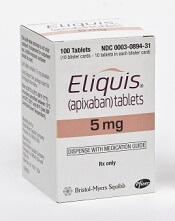
Photo courtesy of Pfizer
and Bristol-Myers Squibb
ROME—Novel oral anticoagulants (NOACs) are as effective as warfarin for preventing stroke but may cause less intracranial hemorrhage (ICH) in patients with atrial fibrillation, according to research presented at ESC Congress 2016.
For this study, investigators compared 3 NOACs—dabigatran, rivaroxaban, and apixaban—to warfarin in a “real-world” setting.
They found that patients had a similar risk of stroke regardless of which drug they received.
However, the risk of ICH was lower with dabigatran and apixaban than with warfarin. There was no significant difference in ICH risk between warfarin and rivaroxaban.
Laila Staerk, PhD, of Gentofte Hospital Copenhagen University Hospital in Hellerup, Denmark, presented these results at the congress as abstract 1875.* The study was supported by Velux Foundations.
“There has been a need to investigate safety and effectiveness of NOACs versus warfarin in a ‘real-world’ population, and our Danish registries provide this opportunity,” Dr Staerk said.
The study included 43,299 atrial fibrillation patients from Danish nationwide administrative registries. Roughly 42% of the patients were taking warfarin, 29% were taking dabigatran, 16% were taking apixaban, and 13% were taking rivaroxaban.
“The inclusion and exclusion criteria in our study were broadly similar for patients initiating NOACs or warfarin, and this gave a straightforward opportunity to directly compare the treatment regimens, which is in contrast to the randomized trials,” Dr Staerk said.
During follow-up, stroke occurred in 1054 patients, and there were 261 intracranial bleeds.
The risk of having a stroke within 1 year was similar between the treatment groups. The absolute standardized risk was 2.01% for warfarin, 2.06% for rivaroxaban, 2.12% for dabigatran, and 2.46% for apixaban.
At 1 year, the standardized absolute risk of ICH was significantly lower in patients treated with dabigatran or apixaban—0.26% and 0.40%, respectively—than in those treated with warfarin—0.60% (P<0.05). The standardized absolute risk of ICH was 0.47% with rivaroxaban, which was not significantly different than the risk with warfarin.
“The results suggest that, although they have similar effects in preventing stroke, dabigatran and apixaban were associated with a safer use regarding the absolute 1-year risk of intracranial bleeding,” Dr Staerk said.
“Our results complement the large, randomized, phase 3 trials by providing ‘real-world’ data on stroke and intracranial bleeding with NOACs versus warfarin since fragile patients were not excluded from our nationwide cohort. For example, patients with increased risk of bleeding, liver disease, and chronic kidney disease are less represented in trials.”
“Registry studies have some limitations, such as the observational design, residual confounding, and confounding by drug indication. In the future, it would be exciting to see a head-to-head, randomized trial performed to compare the different NOAC treatments in patients with atrial fibrillation.”

*Information in the abstract differs from that presented at the meeting.

